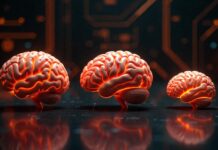
100 years ago, people resided within a society that was markedly distinct from the one we experience today. Humans used gas lamps and horse drawn carriages and they had no idea how will life look like in next 100 years. Fast forward 100 years to the year 2023, and our planet had transformed into a landscape of high-speed internet, virtual reality, artificial intelligence, space exploration, and a global economy more interconnected than ever before. The contrasts between these two points in time are plain, defining a century of remarkable progress, changes and innovation.
The same, and even bigger changes will happen in next 100 years or to be more precise, by year 2100.
In this article, we will take a deep and detailed view into the future and explore the various facets of life in 2100, a life that promises to be even more astonishing and transformative than the changes in life and world witnessed between 20th and 21st century.
So, with, that, let’s dive deep, very deep – into the topics of 22nd century.
Note: The 22nd century will officially begin on January 1, 2101, but nonetheless, let’s stick with the year 2100 as a symbolic number to reveal all the changes, challenges, innovations and potential for both extremely positive and negative future.
Related:
Since this is rather long post, please find below complete table of contents so you can easily decide which part you'd like to read.
Climate Change and Sea Level Rises

In 2100, the consequences of climate change will probably fully realize. The Earth’s climate will be warmer, leading to more frequent and severe weather events. Rising sea levels, once a distant concern, will probably be a present and relentless threat, impacting millions of people living in coastal regions.
Note: By current predictions, in worst scenario the global temperature could rise by 3.3 to 5.7ºC by 2100.
Coastal cities like New York, Tokyo, Mumbai, Venice, Bangkok and many more might experience dramatic transformations. Different systems of sea walls, flood barriers, and advanced drainage infrastructure will be implemented to protect against sea level rise.
Now, one must think about all these (in many cases catastrophic) predictions with a grain of salt. Because those are just predictions. Similar predictions 10 years ago stated that, for example, Miami and many other cities will be slightly underwater by year 2020 and as we know this didn’t happen.
Additionally, we all know that ultra-rich people are constantly buying enormous houses and properties just few meters from seas and oceans.
Well, one would think that if we’re expecting rather significant sea rises, that then mega-rich people (who are always planning for the future), wouldn’t buy such properties.
For sure we’ll see what will happen with sea level rises by 2050 or even sooner and this will then give us more data to work with. Hopefully we will not witness catastrophic scenario because of human activities.
And there will be more human activities and more resources needed because human population will grow.
Population: Africa’s Century
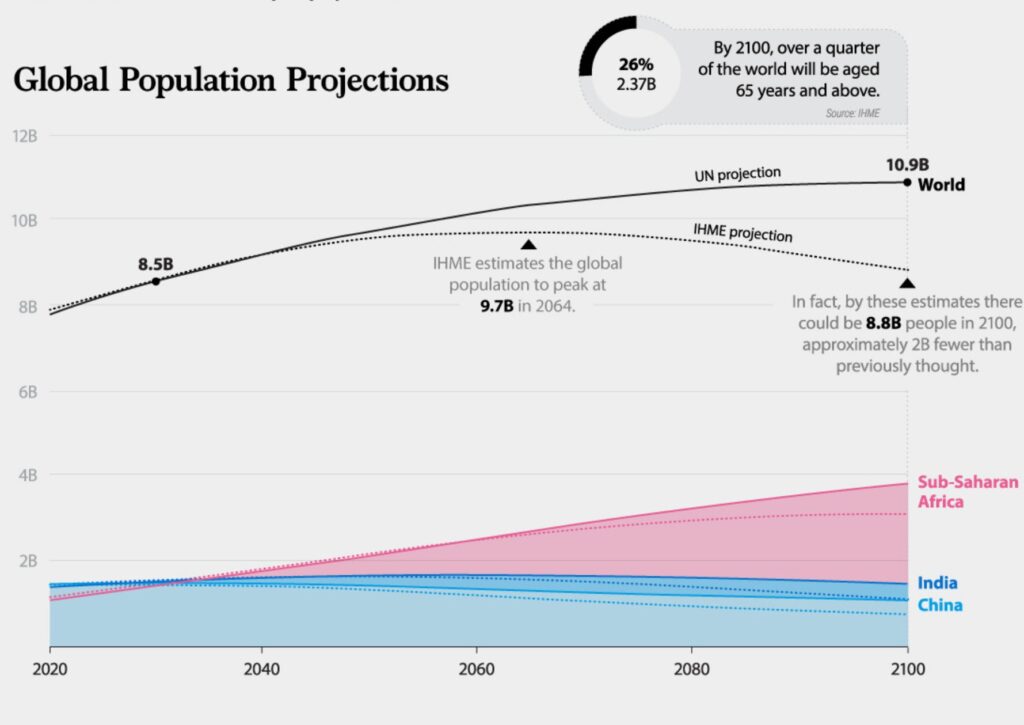
By 2100, the world’s population is projected to reach a staggering 11 billion people. The bulk of this growth will be concentrated in Africa, which will experience a demographic explosion. Factors such as improved healthcare, expanded access to education, and better living conditions will contribute to this population surge.
In fact, World Economic Forum is predicting that Nigeria will be the second biggest country by population with staggering 791 million people. Ethiopia, Egypt & Tanzania will be other African countries entering top 10 countries by population worldwide by 2100.
Africa’s rise as the global growth hotspot presents both opportunities and challenges. The continent will become an economic and cultural powerhouse, contributing significantly to the world’s diversity. However, this demographic shift will strain resources and infrastructure, necessitating innovative solutions for sustainable development and equitable distribution of wealth.
This leads us to topics of economics or to be more specific – poverty in the world.
Less People in Poverty

One of the most remarkable transformations in 2100 will be the dramatic reduction in global poverty. This achievement will be the culmination of decades of efforts in the realms of economic development, healthcare, and education. Emerging economies will become more robust, and developing countries will make substantial steps in bridging the socioeconomic gap.
Access to clean water, improved sanitation, and basic healthcare will become universal rights rather than luxuries. Poverty, although not entirely eradicated, will no longer be a prevalent problem in the world. This shift in the global economic landscape will foster stability, cooperation, and prosperity worldwide.
This will be rather positive movement, if achieved of course. Namely, today, 24% of the world’s population or almost 2 billion people live in some kind of poverty.
But we need to distinct different kinds of poverty.
Roughly 8% of the world’s population resides in conditions of extreme poverty, which means they survive on an income of less than $2.15 per day.
Economy and Digital Money

By 2100, the global economy will undergo a significant transformation. A cashless society will become the new norm, and traditional banks, as we know them today, will give way to decentralized financial systems.
Cryptocurrency, blockchain technology, and decentralized finance (DeFi) platforms will probably evolve in such way that they will play pivotal roles in everyday transactions.
Many countries will have their digital currencies and perhaps there will even be global digital currency.
The transparency and inclusivity of these financial systems will probably minimize the potential for economic inequality by the year 2100.
However, there will also be new challenges, such as the risks associated with digital currencies and ensuring the security & privacy of financial assets.
Urbanization: Megacities and Vertical Expansion
The urban landscape in 2100 will be vastly different from what we know today. Megacities, each housing populations in the tens of millions, will become the standard. To accommodate these massive populations, cities will expand both horizontally and vertically. Skyscrapers will reach incredible heights, and subterranean spaces will be utilized for transportation and infrastructure.
While this urban evolution will offer improved access to amenities and job opportunities, it will also present challenges in terms of resource management, infrastructure development, and maintaining a high quality of life in densely populated areas.
Cities of the future will be testaments to human innovation and the ability to adapt to a rapidly changing world.
That is, of course, if we don’t destroy ourselves before that.
Interesting Fact: The Line is an innovative smart city currently under construction in the Neom region of Tabuk Province, Saudi Arabia. This groundbreaking city is designed to be completely devoid of cars, traditional streets, and carbon emissions, setting a new standard for urban development. Stretching over an impressive 170 kilometers (110 miles), The Line is an integral component of the Saudi Vision 2030 project, which aims to generate approximately 460,000 employment opportunities and contribute an estimated $48 billion to Saudi Arabia's GDP.
Lifespan of People

Advancements in medical science and technology will lead to remarkable increases in human lifespans. Precision medicine, genetic therapies, and regenerative medicine will become integral to healthcare. Living beyond the age of 100 will be a common occurrence, prompting a big reevaluation of retirement, career structures, and intergenerational dynamics.
This demographic shift will have far-reaching implications. A society with a significant elderly population will necessitate innovative approaches to elder care and support systems. Furthermore, the definition of a traditional career will require complete restructuring.
Work Life and Universal Basic Income (UBI)
As mentioned, work structures will evolve significantly by 2100. Automation, artificial intelligence, and digital work platforms will make many traditional jobs obsolete. With the majority of people being self-employed, juggling multiple income sources and career paths, Universal Basic Income (UBI) will become a reality in several countries.
UBI will serve as a social safety net, addressing economic inequality and ensuring that all citizens have access to essential resources. This shift in the workforce will require a reimagining of the social compact, with an emphasis on lifelong learning and adaptability.
However, UBI, even though enticing for many could create many problems for society and individuals.
Related: What would happen in society with limited amount of wealth per person?
Future Jobs: Neuro Practitioners, Space Traffic Controllers, and More
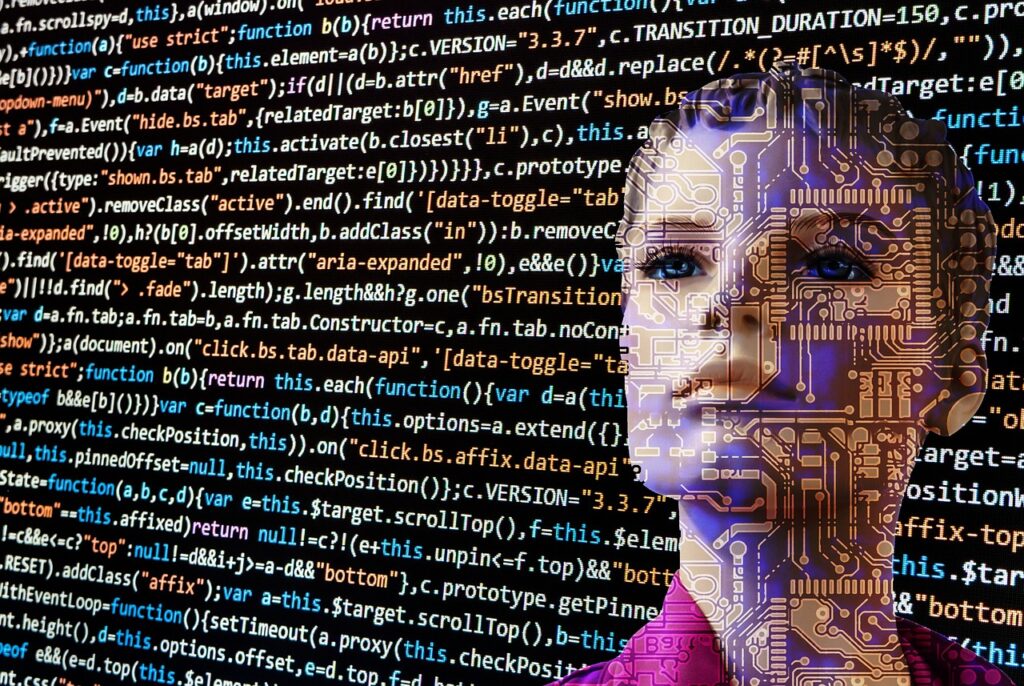
The job market of 2100 will be characterized by challenges and innovation. As automation takes over routine tasks, the demand for jobs requiring uniquely human skills will grow.
Neuropractitioners, specialists in understanding and enhancing cognitive health, will be at the forefront of mental well-being. They will be responsible for developing methods to improve memory, cognition, and emotional well-being, contributing to a more mentally resilient society.
Space traffic controllers will manage the increasingly crowded orbits around Earth, ensuring the safe and efficient operation of satellites and spacecraft. These professionals will be vital in preventing collisions and maintaining the functionality of essential space-based systems.
Robot personalizers will be responsible for customizing AI-driven companions, tailoring their behavior and personality to individual preferences. This field will require a very deep understanding of both technology and human psychology.
Then, we’ll also have so called “gene programmers”.
Gene programmers will create designed customized genetic therapies for various medical conditions, using advanced knowledge of genomics to create tailored solutions for patients.
Food in 2100

The global food supply chain will have a radical transformation by 2100. Traditional agriculture, while still in use, will struggle to meet the demands of a growing global population. Lab-engineered food will become a staple, offering sustainable and highly nutritious alternatives to conventional agriculture.
Lab-grown meats, algae-based proteins, and genetically tailored crops will be among the innovations addressing food security and environmental sustainability.
These engineered foods will be precisely designed to address nutritional deficiencies and minimize the environmental impact of food production. They will play a crucial role in ensuring that the world’s population is well-nourished while mitigating the strain on natural resources.
That being said we could conclude that lab-grown meats will change the food industry forever. It will be such a big change, compared to changes when humans first transitioned from hunter gatherers to food growers.
Controllable Nuclear Fusion in 2100
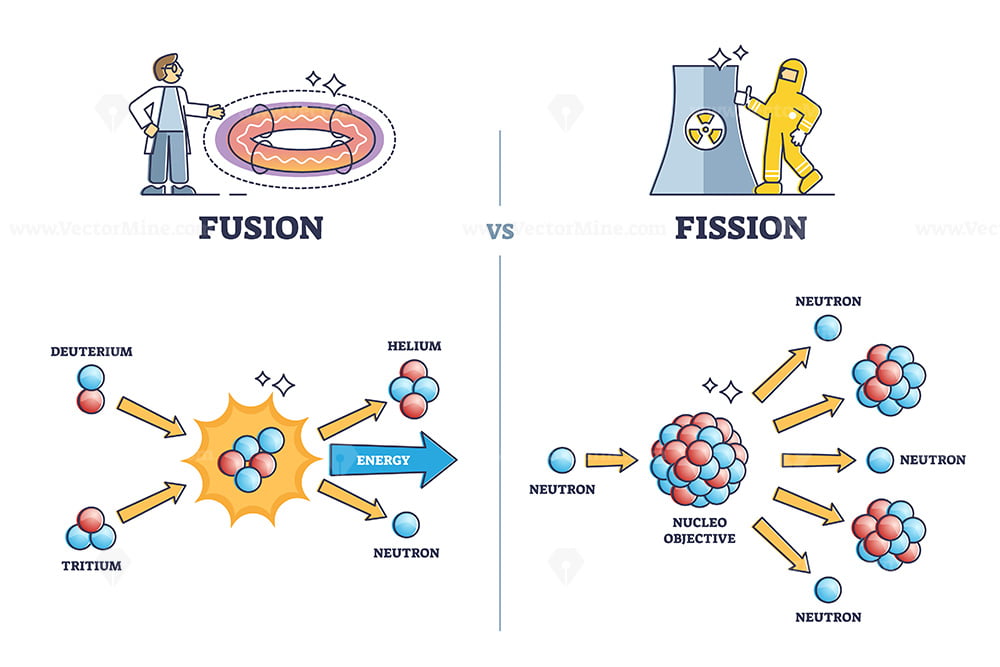
As we look ahead to the year 2100, controllable nuclear fusion could emerge as a potential game-changer in the world of clean energy and carbon reduction. Unlike the prevalent nuclear fission, fusion involves merging two light atomic nuclei, releasing massive energy. Deuterium and tritium, isotopes of hydrogen, serve as readily available fuel sources, making fusion an almost limitless energy supply.
One of the most compelling aspects is its minimal environmental impact, aligning perfectly with the global mission to combat climate change. Nuclear fusion doesn’t emit greenhouse gases or pollutants, making it a truly carbon-free energy source, a crucial requirement in 2100.
In a world where carbon emissions need to be drastically reduced, controllable nuclear fusion could fulfill all our energy needs while drastically cutting our carbon footprint. Practical fusion reactors have the potential to replace fossil fuels entirely, offering a reliable, clean, and virtually limitless source of power.
In addition to being a carbon-neutral energy source, fusion enhances energy security and independence. Nations could generate power domestically, reducing their reliance on global energy markets and mitigating the geopolitical and economic vulnerabilities associated with energy imports.
The economic implications of fusion technology are huge. Building and maintaining fusion reactors, developing associated technologies, and establishing fusion-based energy sectors will create jobs and stimulate economic growth.
While practical fusion power plants are not yet a reality, the progress in fusion research is promising. By the year 2100, fusion has the potential to reshape the world’s energy landscape, providing a clean, abundant, and safe energy source that aligns with the imperative of reducing carbon emissions and combating climate change.
So with that, let’s continue into numerous technological advancements that might happen by year 2100.
Technological Advancements Beyond Imagination
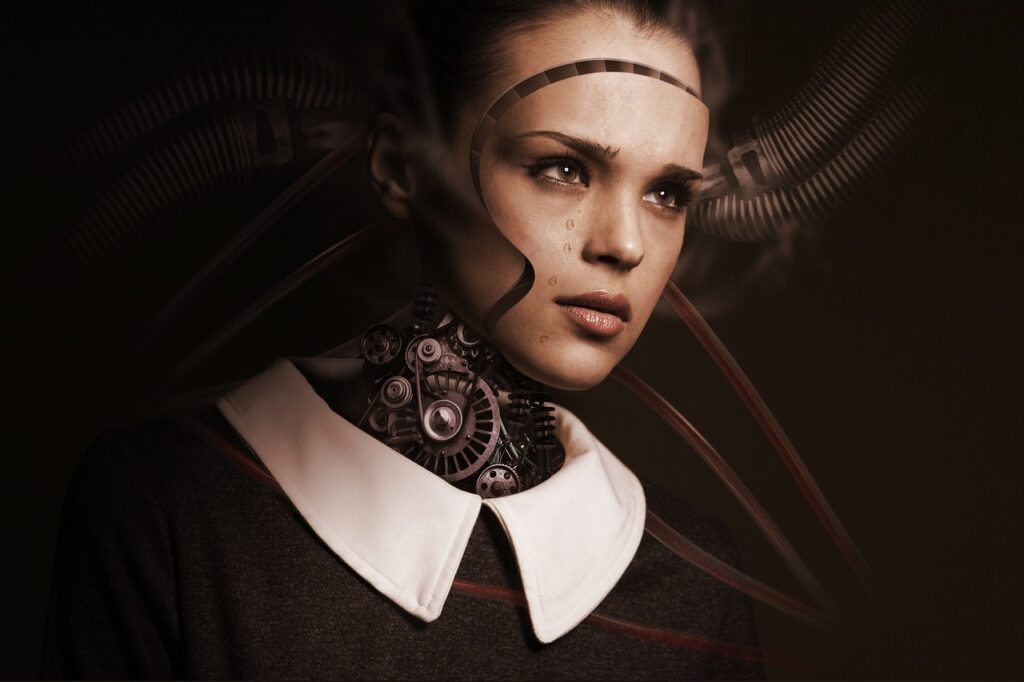
The pace of technological advancement in 2100 will be nothing short of astonishing. Quantum computing will become a reality, offering unprecedented computational power. Nanotechnology will enable the manipulation of matter at the atomic and molecular levels, leading to groundbreaking advances in materials science, medicine, and environmental restoration.
Advanced materials, such as superconductors and carbon nanotubes, will be developed, opening up new possibilities in aerospace, construction, and renewable energy. These technological advancements will drive innovation across various industries and foster breakthroughs that were once deemed impossible.
That said, we need to delve deeper into this topic. Much deeper. Because technology advancements will lead the „humanity train“ into biggest changes (probably) ever.
So, let’s dive into several important categories of technological advancements.
Quantum Computing
Quantum computing, a field once confined to the realm of theory and experimentation, will become a practical and integral part of our daily lives by 2100. Probably even before that. Most likely by year 2050.
These advanced supercomputers will harness the power of quantum bits or qubits, which can exist in multiple states simultaneously, offering computational capabilities beyond anything classical computers can achieve.
Just imagine a world where complex problems, from climate modeling, finance algorithms and drug discovery to cryptography, can be solved in minutes rather than years. Quantum computing will revolutionize industries, drive scientific breakthroughs, and redefine what we consider possible in terms of computation and problem-solving.
Nanotechnology
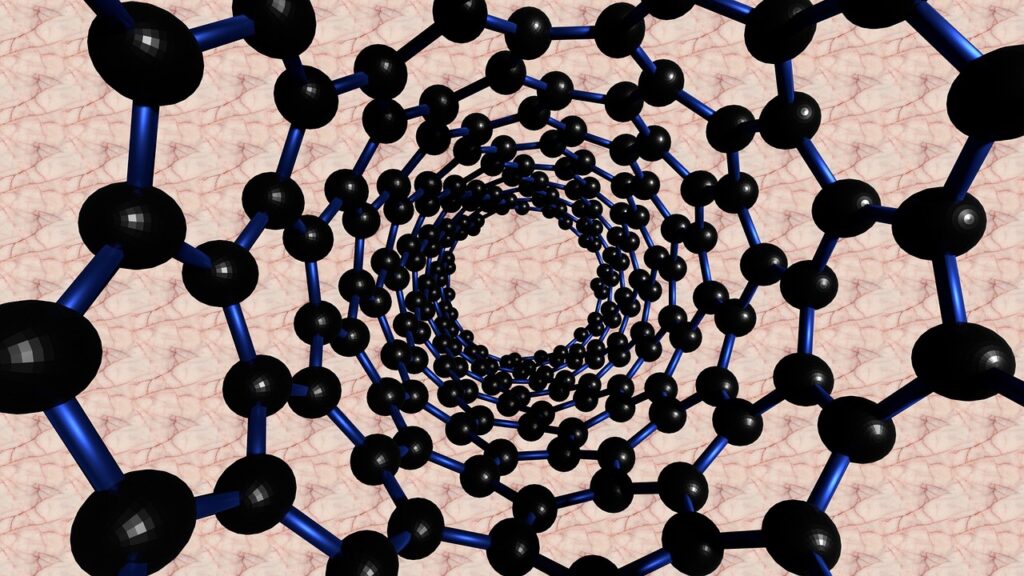
In 2100, nanotechnology will have evolve to a point where we could manipulate matter at the atomic and molecular levels with unparalleled precision. This ability to engineer materials and structures at the nanoscale will have wide-reaching applications, from medicine to materials science and beyond.
One remarkable application will be in the development of advanced materials with superlative properties. Carbon nanotubes, for instance, will be used to create ultra-light and incredibly strong building materials, revolutionizing construction and transportation.
In medicine, nanobots will navigate our bloodstream to target and treat diseases at their source. Nanotechnology will also enable highly efficient energy storage and conversion, leading to cleaner and more sustainable power sources.
Biotechnology & Genetic engineering

By 2100, biotechnology will grant humanity unprecedented control over our genetic makeup. The treatment of genetic diseases, the enhancement of human capabilities, and even the creation of genetically modified organisms will be commonplace. The field of genomics will advance to the point where we could accurately and safely modify our DNA in almost every possible way.
Customized genetic therapies will become routine in the treatment of a wide range of medical conditions, from cancer to genetic disorders. Gene editing will not only be accessible but also highly regulated to ensure ethical use. The ability to eliminate genetic disorders and enhance human traits will need to be balanced by stringent ethical considerations and global regulations.
Having said that, if any of these policies & regulations fail (and some will for sure), then we will have real problems. Just imagine situation where we’d be able to modify gene of embryos in such way that some babies would have IQ of 250. Combine that with unimaginable physical abilities, achieved also by gene modifications, well, then we’re in a challenging situation. By “we” I mean common people. Because, it should be clear that real and efficient gene modification will first become possible for ultra rich & powerful people and their babies.
In such a scenario – those people would have enormous advantage against other people.
We can only hope that this will not happen, and that perhaps it is not happening already in 2023.
With that we’re continuing us to another important topic (perhaps most important ) and this is of course – Artificial Intelligence.
Artificial Intelligence: Sentient and Ethical?
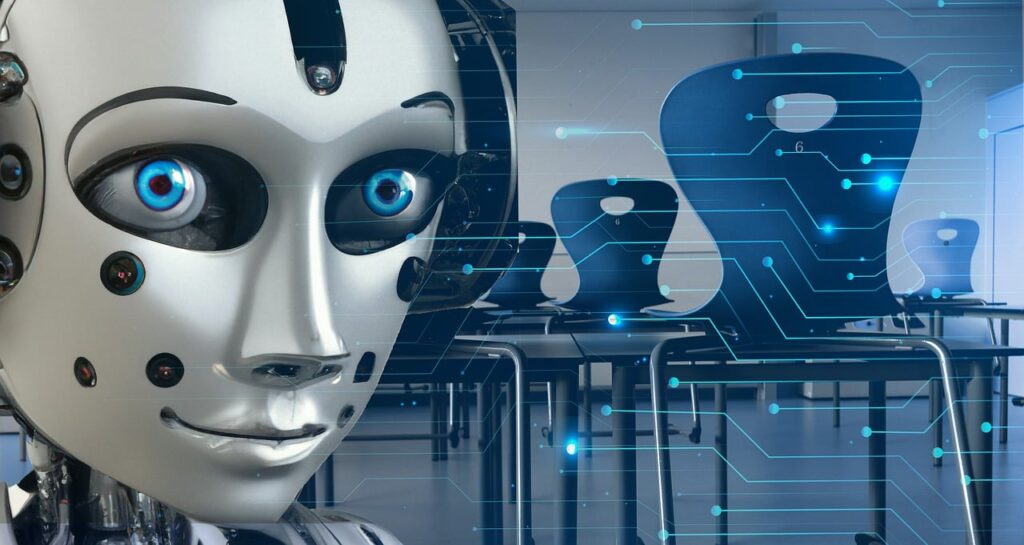
The progression of artificial intelligence (AI) will for sure lead to the development of sentient AI by 2100. These AI entities will possess advanced cognitive abilities, self-awareness, and the capacity for independent thought. As a result, they will integrate into society, contributing to scientific research, healthcare, and various industries.
One of the primary challenges will be ensuring the ethical treatment and coexistence of sentient AI. A new set of laws and regulations will govern their rights and responsibilities, and societies will grapple with philosophical questions surrounding consciousness and personhood. The relationship between humans and sentient AI will be a defining feature of the 22nd century and perhaps for the overall future of humanity.
The Point of Singularity: Merging with Technology
The “singularity,” once a concept relegated to science fiction, will become a prevalent topic in 2100. This, for now, hypothetical moment will happen probably before 2100 and then the artificial intelligence will surpass human intelligence and will be integrated with our lives. This will raise profound questions about the definition of humanity and the implications of our symbiotic relationship with technology.
Society will grapple with issues related to privacy, individuality, and the rights and responsibilities of sentient AI.
The realization of the singularity will challenge our understanding of consciousness, personhood, and the ethical considerations that accompany the creation of sentient beings.
Space Exploration

In 2100, humanity’s reach into the cosmos will be extended far beyond our planet. Human missions to Mars will probably become routine, and discussions about lunar bases and asteroid mining will shift from science fiction to serious consideration.
These endeavors will be fueled by advanced propulsion technologies, resource utilization methods, and international cooperation in space exploration.
One of the most intriguing prospects is the development of space elevators. These structures could provide a cost-effective and efficient means of reaching orbit, dramatically reducing the cost of reaching space. Space elevators might enable the colonization of other celestial bodies, such as the Moon and Mars, and open up new possibilities for resource extraction from asteroids and beyond.
Space Tourism: Extraterrestrial Vacations
With advancements in space technology and commercial space travel, space tourism might become a booming industry by 2100. Ordinary citizens will probably have the opportunity to take vacations in space, orbiting the Earth or visiting lunar resorts. The allure of experiencing weightlessness and witnessing breathtaking views of our planet will drive the demand for space tourism.
These ventures will not only open space to a wider audience but also generate revenue to fund further space exploration. The development of orbital hotels and lunar vacation packages might become a testament to human innovation and the insatiable curiosity that drives us to explore the cosmos.
The biggest problem, of course, will be safety and affordability of so called “space vacations”. However, the same was the case with first cars, airplanes and even vacations in exotic locations. Now, big proportion of humanity already experienced all of those.
For example, On January 29, 1886, Carl Benz applied for a first patent for his vehicle powered by a gas engine and now in 2023 there are there are 1.474 billion cars in the world.
This is not to say that same with happen with space aircrafts, space explorations and space tourism but we could speculate that it will become reality for many people in 2100.
Brain-Computer Interfaces

In 2100, brain-computer interfaces (BCIs) will be advanced to a level where direct communication between the human brain and machines is seamless. These BCIs will enable users to control devices, computers, and even prosthetic limbs with their thoughts. Moreover, BCIs will offer a pathway to enhance human cognitive abilities and expand our understanding of the brain.
The implications of BCIs are profound and almost unimaginable. They will not only improve the lives of individuals with disabilities but also challenge our understanding of privacy, security, and the nature of human consciousness.
Ethical considerations surrounding the use and potential misuse of BCIs will be at the forefront of public discourse.
Namely, the same problem lays in this category as we explained beforehand in the topic of Genetic Engineering. However the problem here will be even larger as some individuals might get this technology much sooner than everyone else, literally making them something straight out of some superhuman movie.
Virtual Reality and Augmented Reality
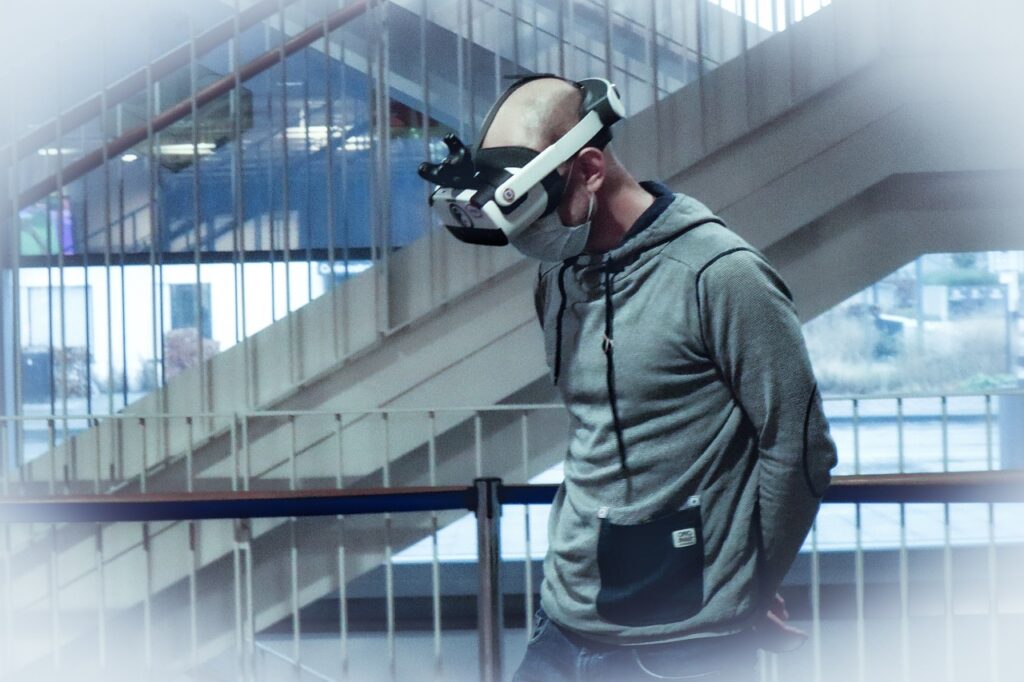
In 2100, virtual reality (VR) and augmented reality (AR) will transcend their current forms, creating immersive and hyper-realistic experiences. These technologies will not only transform entertainment and gaming but also revolutionize education, training, and remote collaboration.
Imagine classrooms where students can explore ancient civilizations in VR or professionals collaborating in AR-enhanced virtual offices. The boundary between the physical and digital worlds will blur, offering new ways to interact with information and each other.
However, this virtual reality world might become problematic for social connections and love life. Some individuals might use those technologies 24/7, becoming virtual reality addicts. This will be a real challenge in year 2100.
Think about addictive properties of today’s social networks and smartphones and then multiply that by 1000 and you can imagine what might happen to humans and their social interactions.
Telepathic Communication: Beyond Verbal Language
In the realm of highly speculative technology, the development of telepathic communication could enable individuals to transmit thoughts, emotions, and information directly to others’ minds. While this concept remains in the realm of science fiction, advances in neurotechnology and brain-computer interfaces may open up new frontiers in human communication by 2100.
Thought-to-Text Technology
In 2100, technology will progress to the point where it could transcribe thoughts directly into text. This groundbreaking development will facilitate communication for individuals with speech impairments and open up new avenues for recording and documenting human experiences. However, again, ethical concerns related to privacy and consent will need to be carefully addressed.
Possibility to Communicate with Animals
Through advanced bioacoustic and neurotechnology, humans may gain the ability to communicate with animals in a limited capacity. While it won’t be a full-fledged “Dr. Doolittle” scenario, we could develop ways to understand and convey basic concepts to our animal companions.
This breakthrough could lead to more profound understanding and enhanced care for the animal kingdom.
Heck, we might even discover that many animals are smarter than us.
Pipenet & Hyperloop: The 5th Mode of Transportation

Pipenet, a revolutionary transportation system, will probably emerge as the fifth mode of transportation by 2100. This network of interconnected tubes or pipelines will transport passengers and cargo at incredible speeds through a low-pressure environment.
Think of it as the next step in the evolution of high-speed trains, offering a more energy-efficient and environmentally friendly alternative to traditional modes of transportation.
Wireless Electricity Grid
By 2100, the traditional power grid will probably transform into a wireless and highly efficient energy distribution system. Electricity will be transmitted wirelessly, eliminating the need for unsightly power lines and enabling convenient charging for electric vehicles and devices. This development will also improve the accessibility of electricity to remote and underserved areas.
Related: What would happen to the world without electricity?
Potential for Cure for Cancer
By 2100, the battle against cancer may finally reach a turning point. Advanced therapies, including nanorobots and precision medicine, will offer highly effective and personalized treatments.
Cancer (hopefully) may no longer be the dreaded diagnosis it is today, as science and technology will work together to conquer this relentless disease.
Perhaps by year 2100, cancer will become something treatable as easy as common flu.
Creating Younger Versions of Ourselves

Advancements in regenerative medicine and anti-aging technologies may allow individuals in 2100 to rejuvenate their bodies and extend their youth. While immortality remains elusive, the ability to “reset” one’s biological age and maintain vitality for more extended periods will have profound implications for healthcare, retirement, and quality of life.
In conclusion, the future technologies of 2100 promise to be both awe-inspiring and challenging. Quantum computing, nanotechnology, biotechnology, AI, space exploration, and speculative technologies will reshape the world as we know it.
Navigating this brave new world will require a delicate balance of innovation, ethics, and global cooperation, ensuring that technology serves the betterment of humanity as a whole and not a conqueror of humanity.
That last sentence leads us to rather important question: “With all that advanced technology, will we perhaps destroy ourselves?”
Potential for Humanity’s Self-Destruction

As humanity marches forward, the potential for self-destruction remains an ever-present concern. The 21st century has seen the proliferation of powerful technologies, including nuclear weapons, bioterrorism, and (already) misuse of artificial intelligence. In 2100, the world will grapple with the continued existence of these existential threats.
International agreements and governance systems will be imperative in mitigating the risk of global conflicts and ensuring the responsible use of advanced technologies.
While humanity will make a remarkable progress, the risky balance between progress and threat will remain, underscoring the need for responsible global governance.
Military: Robo-Soldiers and Unmanned Warfare

The military landscape will be virtually unrecognizable in 2100. Robo-soldiers, autonomous drones, and AI-driven weapons will redefine the nature of warfare. Human soldiers will assume more specialized roles, while robots handle frontline combat. The moral, legal, and strategic implications of autonomous warfare will remain a subject of ongoing debate.
International agreements will be crucial in managing the proliferation of AI in the military and in establishing protocols for the responsible deployment of such technologies. While these innovations offer potential benefits, they also pose huge risks that require very very careful consideration.
World Order and Political System in 2100
The political landscape in 2100 will be marked by seismic shifts. The emergence of new global powers and alliances will redefine the traditional world order. While the concept of a world government may still be a distant goal, it will be debated more earnestly as nations collaborate on a larger scale to address shared global challenges, such as climate change, resource management, and pandemics.
New international institutions will be established to ensure global stability, security, and cooperation. The reconfiguration of the world order will require innovative approaches to diplomacy and governance, emphasizing cooperation and the shared responsibility of nations for the well-being of the planet.
Wars and AI Superpowers
Artificial intelligence will become a game-changer in warfare by 2100. AI superpowers will emerge for sure, leveraging advanced algorithms and autonomous systems in conflicts.
This shift raises significant concerns about the AI-driven warfare. The use of AI in military operations might resolve never-ending human conflicts but it also might pose significant risk for destruction of nations or overall humanity.
The development of AI-driven weapons systems will necessitate a new understanding of conflict and security. These technologies will not only redefine the nature of warfare but also the standards of conduct in international relations.
Recommendation: If you’re curious about AI superpowers we’d highly recommend following book: “AI Superpowers: China, Silicon Valley, and the New World Order“.
Sexlessness and Love Life in 2100
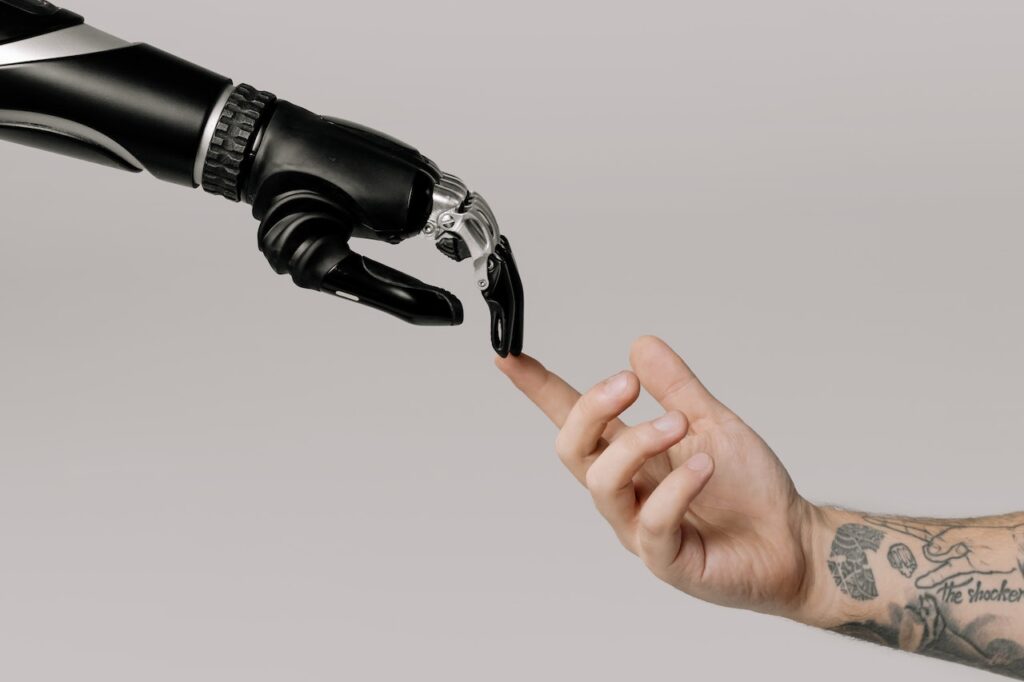
The concept of sexlessness will (de)evolve societal perspectives on relationships. In 2100, more individuals will probably choose asexuality or low-sexuality lifestyles, challenging traditional norms of intimate relationships. Asexuality will gain recognition and acceptance but will also raise significant problems in society.
Love and relationships will be profoundly and probably negatively influenced by digital technologies and the cultivation of emotional intelligence. Virtual relationships and AI-driven companions will become more common.
The ability to understand, express, and manage emotions will be essential in navigating the complexities of modern relationships. Emotional literacy will need to be incorporated into education, fostering “healthier” and more fulfilling connections between individuals and machines.
Moreover, the emotional bonds formed with AI-driven companions will raise questions about the nature of love and the boundaries of human-technology relationships.
This poses the question: Should we perhaps stop the development of such technologies? Will this lead to complete dystopia?
Potential for Dystopia: The Dark Side of Progress
As we envision the world of 2100, it is crucial to acknowledge the potential for dystopian outcomes. The misuse of technology, uncontrolled environmental degradation, and political conflicts could result in a future where human rights are eroded, privacy is compromised, and social divisions intensify. To avoid this dystopian trajectory, responsible governance, ethical leadership, and global cooperation will be paramount.
And this leads us to the final chapter of this article. What could go wrong?
Let’s see…
What Could Go Wrong by 2100: Top 5 Examples

- Environmental Collapse: Failure to adequately address climate change and resource management could lead to widespread environmental collapse. This includes food shortages, water scarcity, and the displacement of millions due to rising sea levels.
- Technology-Induced Inequality: The unequal distribution of technological advancements and their benefits could result in a unimaginable digital divide, exacerbating socioeconomic disparities and hindering equal access to normal life and opportunities in life.
- AI Control and Ethics: The uncontrolled development of artificial intelligence, particularly in military and governance, could lead to a loss of control over these systems. Ethical dilemmas surrounding AI autonomy and accountability may undermine global security.
- Biotechnology Misuse: The misuse of biotechnology, including genetic engineering, could result in unintended consequences, such as the creation of bioengineered super-humans and weapons.
- Global Political Conflicts: A failure to establish effective international governance mechanisms and global cooperation could lead to heightened tensions and conflicts between nations. Competing interests in resources, territory, and strategic advantages may escalate into wars with devastating consequences.
In conclusion, the world in 2100 is a realm of unparalleled potential, but it also carries the weight of unimaginable challenges. While we can anticipate remarkable advancements in science, technology, and human well-being, it is imperative to address the ethical, social, and environmental issues that could lead to dystopian scenarios.
By fostering responsible innovation, global cooperation, and a commitment to sustainable progress, we can strive for a future where the promises of 2100 outweigh the perils, ensuring a world that future generations can inherit with hope and optimism.
If we continue technological progress (and we will), we really need to think years, if not centuries ahead. Some technologies could destroy pure fabrics of our society.
People are social beings and if we end up depending on technology 24/7 then we will be in a real problem.
But let’s end up with a positive note. As far as we know, almost every new generation are living better lives than generations before.
Hopefully this will continue for the years and centuries to come.


















